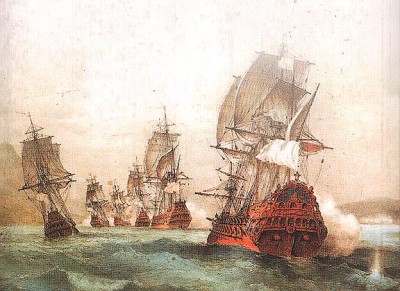Duguay-Trouin’s fleet.
Duguay-Trouin’s fleet shoots its way into Rio de Janeiro; north is to the right.
SEPTEMBER 12, 1711.
The Saint Malo privateer René Duguay-Trouin appears off Brazil with his 74-gun, 1,400-ton, 678-man flagship Lys and its sister ship Magnanime under the Chevalier de Courserac; the 64-gun, 1,100-ton, 550-man Brillant of the Chevalier de Goyon Beaufort, Achille of Pierre de Rémy, Chevalier de Beauve, and Glorieux of Captain de la Jaille; the 58-gun, 800-ton, 486-man Fidele of Miniac de la Moinerie; the 54-gun, 600-ton, 480-man Mars of Joseph Danycan; the royal frigates Argonaute of 46 guns, 500 tons, and 336 men under 28-year-old Emmanuel Auguste de Cahideuc, Chevalier Dubois de La Motte; Amazone of 36 guns, 450 tons, and 318 men under Lefer des Chesnais Le Fer; Aigle of 36 guns, 300 tons, and 238 men under de La Marre de Caen; Astrée of 22 guns, 250 tons, and 160 men under Rogon de Kertanguy; the victualler Concorde of 20 guns, 250 tons, and 300 men under Daniel de Pradel; the privateer frigates Chancelier of 40 guns and 246 men under du Rocher Danycan, and Glorieuse of 34 guns and 227 men under de la Perche; as well as the former galliot Bellone of 30 guns, 340 tons, and 229 men under de Kergu.
Although most of this fleet has been loaned by the French Crown, its financing comes from private sources. At 38 years of age, its commander has won fame as a brilliant commerce raider. Masked by mists and propelled by a favorable wind, Duguay-Trouin decides to burst directly into Rio’s harbor, despite the formidable batteries covering its narrow entrance: 44-gun Fort Santa Cruz on its eastern shore, plus the 48 guns of Fort Sao Joao and Praya Vermelha on its western side. Fighting their way in behind Courserac (who is familiar with this roadstead), the French encounter four Portuguese warships and two frigates inside under Commo. Gaspar da Costa, who cuts his cables and grounds his ships beneath the protection from Rio’s ramparts. At a cost of 300 total casualties, Duguay-Trouin has penetrated the harbor.
The next dawn, the Chevalier de Goyon occupies Cobras Island, where a French battery of 18 guns and 5 mortars is quickly installed. Duguay- Trouin meanwhile circles Rio on September 14 and, supported by covering fi re from the Mars, disembarks more than 2,800 soldiers and sailors within a half mile of its walls. Before sunrise the next day, his encampment is struck by 1,500 Portuguese militia counterattackers, who are driven off after a sharp exchange. On September 19, Duguay-Trouin calls upon Rio’s governor, Francisco de Castro Morais, to surrender. When this demand is rejected, the French begin a combined bombardment with their siege batteries and warships.
At 1:00 a. m. on September 21, a French prisoner slips out of Rio to advise the besiegers that the Portuguese have abandoned their city. Duguay-Trouin consequently occupies Rio, freeing 360 survivors from du Clerc’s failed expedition of 1710. His second-in-command, Major General de Beauville, accepts the capitulation of the Portuguese harbor batteries, while Governor Castro withdraws five miles inland in the vain hope of being reinforced from Sao Paulo and Minas Gerias by Capt. Gen. Antonio de Albuquerque Coelho de Carvalho. The French loot the city warehouses, as well as 35 large and two-dozen small anchored vessels, before demanding a ransom to spare Rio’s buildings. As any effective Portuguese military response is being hampered by renewed disturbances against the governor general at Salvador, as well as by lingering animosity between the twin Pernambucan cities of Olinda and Recife, the defenders reluctantly pay on October 10-although only 610,000 cruzados, far less than Duguay-Trouin expects.
The French then depart on November 13, having incorporated the 56-gun, 550-ton Nossa Senhora da Encarnacao and the 44-gun Reinha dos Anjos into their fleet while burning the remainder. At a cost of 500 invaders’ lives, Duguay-Trouin has devastated the city and burned almost 60 Portuguese merchantmen, but profits will prove to be disappointing for his investors. Moreover, the heavy-laden Magnanime and Fidele are lost with all hands during his subsequent homeward passage on January 29, 1712, whereas the Aigle succumbs at anchor off Cayenne, prompting Duguay-Trouin’s shareholders to complain bitterly once he regains Brest on February 8.
